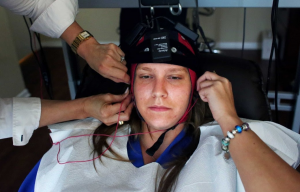Glenna Gasper in our chat last evening we offhandedly chatted about. . . The Shock of a Cancer Dx, emotional conflict and how to overcome that. SO in this blog post. . . . I will go inside your mind and show you what is happening & give you a better understanding how to correct this. It was on February 24 2005 that my own father was told it was time for his cancer “leiomyosarcoma” to run its course. It was my belief he was now . . . in his 80’s . . . his insurance company red flagged him.
Talk about messed up. . .my life stopped instantly. For the next 14 months. . . . as we waited through his death sentence. . . .it was very taxing. Ultimately it caused me “severe depression. Believe ME: I know what cancer patients go through and it changed my life forever. Since his death on April 3rd 2006. I have been researching cancer and that’s how cancer changes you in the beginning, duration and in the aftermath?
Human beings possess a capability far beyond animals. Many ideas exist to explain the mind, but few understand the truth. https://rcg.org/realtruth/articles/090806-002-science.html
Happy Brain, Happy Life
Happy brains are more creative, quicker, and more mentally alert!!!
Every cell in your body is replaced about every two months. So, the good news is, you can reprogram your pessimistic cells to be more optimistic by adopting positive thinking practices, like mindfulness and gratitude, for permanent results. Your Thoughts Activate Your Genes. You are speaking to your genes with every thought you have.
Fear can make your spine tingle and your hair stand on end, but can being afraid actually kill you? “There’s absolutely no doubt about it,” according to Dr. Martin Samuels, the chairman of neurology at Brigham and Women’s Hospital in Boston.
Paula A. Johnson, MD, MPH, Executive Director, Connors Center for Women’s Health and Gender Biology, and also Chief, Division of Women’s Health, Brigham and Women’s Hospital, leads a panel discussion stress with Martin A. Samuels, MD, Chair, Department of Neurology, Brigham and Women’s Hospital and Helene Langevin, MD, CM, Director, Osher Center for Integrative Medicine, Brigham and Women’s Hospital about the impact of stress on women’s mental and physical health as well as medical and non-medical approaches for relieving the symptoms arising from stress. https://www.youtube.com/watch?v=s7rR1r8tCYU
92% of what we worry about never happens, so why are we so afraid to face our fears? In this episode, Shelby and Josh sit down with SUCCESS associate editor Jamie Friedlander who tried to conquer her fear of public speaking by taking on standup comedy. Plus we reveal our biggest fears and how we faced them head on… or not. And then we take a look at the science behind our most basic instincts of fight or flight in a conversation with Jeff Wise, the author of Extreme Fear: The Science of Your Mind in Danger.
I learned a long time ago: Never Judge a Restaurant by its exterior, for its the people on the inside that matters!!
In ancient Greek medicine illness was initially regarded as a divine punishment and healing as, quite literally, a Gift from the Gods. However, by the 5th century BCE, there were attempts to identify the material causes for illnesses rather than spiritual ones and this led to a move away from superstition towards scientific enquiry, although, in reality, the two would never be wholly separated.
From the time of the ancient Greeks, medical practitioners have searched biomarkers for physical illnesses. More recently, doctors relied on patients’ complaints about the severity of their chest pains in order to diagnose a heart attack. Today, they measure cardiac enzymes in the bloodstream. “Cancer treatment doesn’t treat the symptoms of cancer. You don’t want the swelling to go down or the pain to disappear; you just want to get rid of the cancer,” said Kenneth Kaitin, director of the Tufts University Center for the Study of Drug Development. “But that’s what we’re doing in psychiatry,” treating the symptoms of mental disorders — the sadness or the restlessness or the hallucinations — not the causes.
Science Plus: how fear is wired in our brains!!!
What is known is that the brain looks different in those who struggle from traumatic experiences. . Post-traumatic stress disorder, for instance, occurs because of emotionally scarring experiences, but those experiences change the brain and the brain’s responses to the environment.
Tina Raymond, 61, says her treatment produced almost immediate results. In 2006, Raymond was robbed and beaten inside her storefront office in Mount Vernon, N.Y., where she designed seasonal displays for department stores. She saw several doctors, including Asif, for memory loss and PTSD from the attack, and she eventually recovered.
Then, in May 2014, just as Asif was ramping up his neurotherapy practice, Raymond returned, complaining of feelings of worthlessness.“ I was hitting a lull, an emotional lull,” she said. “I was depressed. Getting out of bed was harder than usual. I’m a pretty upbeat person in general, so for depression to hit me it was distressing.”
Raymond filled out the color-coded form and scored the statements on a scale of 0 to 10, with 10 being the highest.
“I feel unfocused, tired, and bored.”
“I have difficulty planning and organizing.”
“I worry a lot, and have difficulty stopping repetitive negative thoughts and actions,” Asif next wired Raymond for a qEEG. The most striking image was a red blotch on the right side of her brain map, indicating too much slow-wave delta activity in the temple area. It’s a part of the brain that plays a role in mood regulation and motivation, and it wasn’t firing properly or communicating well with the left side of her brain. Asif now had his target areas. He would use neurofeedback, employing a video-aided reward system, to retrain Raymond’s brain.
Neurofeedback is a descendant of biofeedback, which uses medical instruments, such as a blood pressure cuff, to monitor body functions and relay the information to patients who then try to alter their physical responses. Neurofeedback has had a popular, if controversial, commercial application as a kind of relaxation therapy, but recently psychiatry has studied it in combination with real-time brain imaging.
n 2013, for example, a team at Yale University found that neurofeedback used with functional MRI, another brain imaging technology, substantially reduced depression and anxiety in patients.
For some neurofeedback sessions, Asif plays a pleasant nature movie during which the patient’s brain-wave activity is automatically compared every half-second to the goal. If the two are in sync, the patient’s brain is “rewarded” by the movie’s continuation. If they are not, the movie stops. Which means that in one 50-minute session, Raymond’s brain experienced 6,000 chances to be “rewarded” for learning how to reduce the delta-wave activity in the right hemisphere and re-establish its normal firing pattern.
If all this seems mysterious, scientists say it is no more inexplicable than children learning on their own how to play a video game or ride a bicycle. Our brains simply figure things out because that’s what they were built to do. For patients, the sense of control over their own treatment, of helping to heal themselves, is often exhilarating.
After those five sessions, Raymond felt her depression lift. Those overactive delta waves nearly disappeared, and her improving mood matched her brain map, evident by the diagnostic form she filled in before each session. Soon the 9’s and 7’s she had recorded before her first session were manageable 2’s and 3’s. She felt better in the same amount of time it takes for most psychiatric medications to begin working, and she experienced no side effects, except for the goop in her hair after each session.
Asif, she said, “ put my pieces back together.”
Internist Alexis Gopal often referred patients to Asif.
“I’ve sent him adolescents who have gone to successive psychiatrists and medication after medication, and he can turn them around in two or three treatments,” said Gopal, who lives in Danbury, Conn., and now runs her own medical communications business.
For several years the doctor had dealt with her own, occasionally paralyzing anxiety, for which she took medication. When the problems worsened in 2014, she turned to Asif.
Gopal was skeptical about neurofeedback, having undergone biofeedback sessions for migraines with another doctor; they hadn’t helped. Then Gopal went through Asif’’s movie-watching exercise. She also listened to a series of pleasant tones that degenerated into noise if she didn’t focus on modulating her brain-wave activity.
“You have to relax. And he tells you to focus on something,” she said. “I also remember specifically one session feeling like I was going to crawl out of my skin. And I remember at the end of one session I felt so relaxed and so calm, I thought, ‘Wow, this really works.”
Asif charges between $275 and $350 per session after an initial interview and evaluation, which includes a qEEG and costs about $550. Sessions are billed as either psychotherapy or medication management for insurance purposes.
Gopal said that she felt better with each visit, and there was a side benefit: Her migraines ended.
The Brain’s Biology: A Negative Feedback Loop System
January 20 2012
Are you ready for a challenge? I want you to make a list of all of the things that your child or children have done right today. Go ahead, pull out a blank piece of paper or a blank computer screen and begin listing everything where your child did and behaved as you wanted him to. I’ll wait while you take the time to actually complete this task.
Okay, now list the opposite. On the other side of the paper, or after creating a page break, list all of the things where your child did not do what you asked, did not listen to you, misbehaved – times when you felt annoyed, upset or aggravated.
For those of you reluctant to take the extra step of actually making the list, I guarantee you that making this little effort will have greater impact and help your learning.
Our brain is a feedback loop system. In fact, it isn’t just the brain that is a feedback loop system. Every system and cell in our body is a feedback loop system. For the purpose of understanding life on a grand level, let’s talk about understanding the implications of this feedback loop system.
The human brain is a negative feedback loop systems. This means that whenever there is a difference between what a person experiences in reality that is different from the ideal set point established by this person’s brain, an urge to also behave to correct the situation is created by the brain. For example, each person has a comfortable room temperature as his ideal set point.
When the room temperature dips below the ideal, the person will take action to correct the situation and re-establish the environment to match the comfortable room temperature set point established by this person. The creativity and adaptability of being human means you can choose from a wide variety of solutions to increase your warmth. You can put on warmer clothes. You can exercise, increasing your own internal temperature. You can build a fire, or turn up the heat, or sit in a sunny spot in the room. But any action you take is generated by the signal your brain gives you that what you want does not match what you are getting.
The important point to understand is that your brain is set up to notice what is wrong; to notice the exceptions, the mismatches, the painful areas that are out of order. It is the mismatch between what you want and what you are getting that creates the signal for you to take action.
Your brain does not notice when what you want matches what you are getting. You don’t pay attention. Because there is no signal generated by your brain, you aren’t even aware of it.
There are exceptions. When you finally get what you want after being out of balance for an extended time, the relief of the match feels wonderful. Remember the joy and relief you have felt when you finally entered a warm room after being cold for too long? Sipping a hot beverage, snuggled up next to a fire after being outside in the cold for several hours, feels delightful. This match is a relief and is very much part of your awareness and gratitude.
But, are you aware of the temperature in the room you are in right now? If you are too cold or too warm, then you probably are aware of it. But if you are in a comfortable room, you haven’t even noticed the temperature. Your brain functions to bring your awareness and action to situations when there is a mismatch – not when there is comfort, satisfaction, and a match.
Now let’s apply this idea to your interactions and relationship with children. As a classroom teacher, you are very aware of the children who are misbehaving in your classroom. Are you aware of the children who are cooperating, learning, and engaged?
Don’t despair if you are only paying attention to the misbehaving children. It is how your brain functions. Your brain’s biology signals you into action when misbehaving children are present. Your brain’s biology gives you no notice of the well-behaved, cooperative children. They go unnoticed.
Because children’s brains function the same way, your students may not be aware of what they are doing well, where they are achieving, and where they are being successful. In order for this to happen, they have to go against their brain’s biology and extend extra effort to find the moments and also areas where their achievement matches their desired outcome. Looking for successful accomplishments, especially small and minor ones, is not part of our nature.
Going one step further by asking her what she did to be successful helps her learn, internalize, and grow to master the effective skills and habits she is developing. Does she know what she can do to have even more success? Although, it may feel as if things just turned out well without any effort on the child’s part, asking children to notice what they did well will maximize their learning because their brain is not going to automatically notice when there is a match. Without your helpful intervention, the brain will only notice the mismatch.
Are you aware of all of the ways your child is listening, is cooperating, and is doing just what you want? If you are, then this is probably a habit that took time and effort for you to develop.
At the beginning of this article, I asked you to list the delightful matches between what you wanted and what you were getting from your child. I also asked you to list the mismatches where what you wanted from your child was different from what your were getting.
Which of these two lists was easier for you to make?
If you’re like most people, the mismatches were quicker and easier for you to identify than the matches. Why? Because the biology of our brain is a negative feedback loop, giving us feedback and urging us to behave when we are not getting what we want.
With this powerful information you can make dramatic changes. For the next week, start paying attention to all of the ways that life is working out for you. For instance, the next time you drive to work, notice how many other drivers are cooperating with you, driving safely, everyone free from an accident and danger. There may be one or two drivers who are the unfortunate exception, but the vast majority of people on the road with you are safe, cooperative drivers.
For the next week, notice all the ways your child is doing well, cooperating, and helping, being pleasant, friendly, and loving. There may be moments when he sasses you or she whines, but the vast majority of your life together is filled with cooperative and pleasant moments.
Teachers, the next time you enter the staff room, celebrate with your colleagues about the 22 students who were working cooperatively with you on your most recent lesson rather than the one or two students who disrupted.
Are you getting the picture? You have to go against your biology, against your brain, to notice all of the matches – the pleasant, stress-free moments in your life and with your child. As you practice this skill more and more, it becomes a habit – one that will bring you joy.
This is a powerful skill to teach children as well. When children notice their success, happiness, and achievement, and also attribute it to their own effective behaviors, they understand that what they do on a daily basis helps them meet their needs responsibly. They understand that their happiness is up to them and not dependent on anyone else. What a great gift of understanding to give to a child!
About the author – Nancy Buck
 Nancy S. Buck, Ph.D. is a developmental psychologist, expert in children’s motivation and behavior, and parenting coach. Fresh, funny and unafraid, she tackles the tough topics facing all families today. As the founder of Peaceful Parenting Inc®, blogger for Psychology Today and author of Peaceful Parenting and Why Do Kids Act That Way? The Instruction Manual Parents Need to Understand Children at Every Age, she gives lively presentations that audiences relate to and remember. To learn more or to contact Dr. Buck, visit PeacefulParenting.com.
Nancy S. Buck, Ph.D. is a developmental psychologist, expert in children’s motivation and behavior, and parenting coach. Fresh, funny and unafraid, she tackles the tough topics facing all families today. As the founder of Peaceful Parenting Inc®, blogger for Psychology Today and author of Peaceful Parenting and Why Do Kids Act That Way? The Instruction Manual Parents Need to Understand Children at Every Age, she gives lively presentations that audiences relate to and remember. To learn more or to contact Dr. Buck, visit PeacefulParenting.com.
In Philippians 4:7 we have a wonderful promise: “The peace of God, which passes all understanding, will guard your hearts and your minds in Christ Jesus.” It is important to note the context of this promise, because that’s where we find the condition: “Do not be anxious about anything, but in every situation, by prayer and petition, with thanksgiving, present your requests to God.” God’s peace is promised to guard those who pray—with thanksgiving—about everything.
This peace will transcend our ability to understand it.
The believer who places his or her full confidence in a loving God and is thankful in every circumstance will possess a supernatural peace. An inner calm will dominate the heart. The faithful believer will know peace—his heart and mind are “guarded” by it—despite the tempest raging without. No one, especially those outside of Christ, will be able to fathom that peace. To most, it will remain a mystery how someone can be so serene in the midst of turmoil.
God’s supernatural peace surpasses natural understanding. A cancer patient who experiences a remission of the disease may proclaim, “I am so thankful to God!” That is praise. A cancer patient who is dying and in pain may calmly say, “Everything is all right. I claim Romans 8:28, I have peace in my heart.” That is “the peace that passes all understanding.”
Recommended Resource: Peace: Overcoming Anxiety and Conflict by Jack Kuhatschek




 Marris Szeliga, a patient and employee of psychiatrist Hasan Asif, is fitted with an EEG cap that will allow him to analyze her brain-wave activity.
Marris Szeliga, a patient and employee of psychiatrist Hasan Asif, is fitted with an EEG cap that will allow him to analyze her brain-wave activity.